This post was last updated on November 21, 2022 by Preethi Sukumaran
At Krya, we LOVE Face Masks / Lepas.
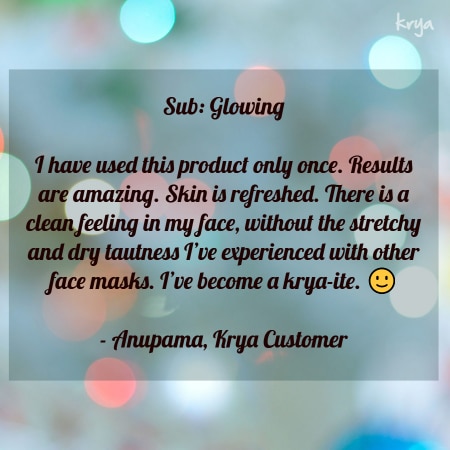
We love the way they make us and our costumers feel. We love how quickly and beautifully they work on skin – (some Krya customers swear by the “instant plumping and glow” they get after a single Face Mask / Lepa application. We love how well researched and through the acharyas are in recommending what herb goes into what Lepa.
Most of all we love how beneficial a Face Mask / Lepa is: they are not just pick me ups or feel good products (although they do pick us up and make us feel really good), but help effectively balance aggravated Doshas on skin.
If you have only used synthetic sheet masks or synthetic face masks, you might find that using an Ayurvedic Face Mask / Lepa is quite different. Information available online is also quite frankly patchy and sometimes extremely inaccurate. So here is a post to help you use your Ayurvedic Face Mask / Lepa correctly.
What is an Ayurvedic Face Mask / Lepa? How is it different from a beauty face Mask?
An Ayurvedic Skin Mask / Lepa is a Face Mask formulation that is made ONLY from carefully chosen and uniquely processed Ayurvedic herbs, Lentils and Grains. Depending upon the skin issue we are trying to resolve, each Lepa formulation will contain a unique set of herbs, a unique set of processing techniques, and will suggest using a unique Anupana (medium) to mix the Mask in.
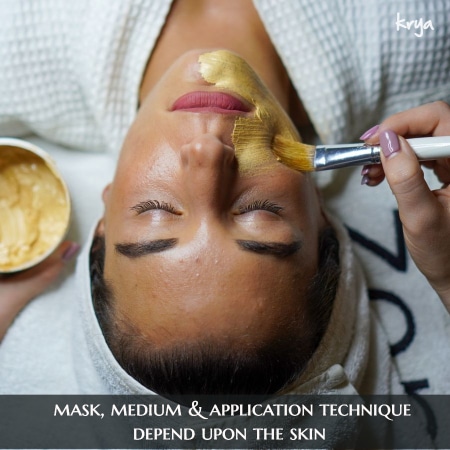
Lepas (masks) in Ayurveda are used not just to improve skin condition. They are also used variously to heal wounds (vrana ropana), reduce inflammation (shopha), reduce oedema , etc. Depending on whether we are trying to shrink inflammations, open up the Srotas (fine channels of skin) or improve skin complexion and texture, the temperature of the Lepa, the Anupana or mixing Medium and thickness of application all vary.
Ayurvedic Face Masks / Lepas to improve Skin – Varnya Lepa
Varnya or skin complexion and texture is a rather complex term in Ayurveda. Unlike the modern obsession with skin lightening, varnya is a more complex and subtle skin quality. Varnya covers both tejas (lustre) of skin, and its texture (smoothness and capacity to evenly reflect light). For skin tejas (lustre and glow), smoothness of complexion, softness of skin and plumpness of skin, we need the combined forces of Pitta, Vata and Kapha dosha to be in balance.
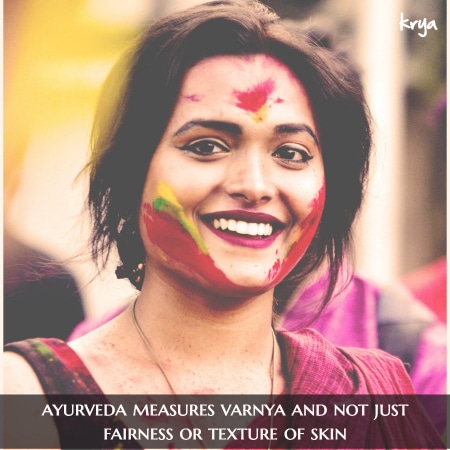
Many of us are never completely in balance. Due to poor eating, stress, late nights or simply not following the prescribed Dinacharya and Ritucharya, sometimes our skin may not look its best. This could be further aggravated by unique conditions we face like pregnancy, being post partum, going through a difficult phase in life, stress at work, etc.
When our Vata is out of control, we may see dryness, and a lack of skin lustre and roughness of skin. When Pitta is out of control, we might see blotchiness and redness, high skin sensitivity to sun and frequent eruptions and breakouts. When Kapha is aggravated, we might see ripening of acne, smoothness of skin could be low and skin could look dull. Sometimes we can also see a combination of symptoms if more than one dosha is aggravated.
For Masks / Lepas used for “varnya” (complexion improvement) in Ayurveda, we generally choose herbs that open up the Srotas and cleanse well. We also choose herbs with different rasas or tastes depending upon the skin issue we are trying to solve.
For pitta related issues like skin that flushes easily, rosacea, sun burns and pitta related pigmentation we choose herbs with Kashaya and tikta rasa (astringent and biter tastes). This helps balance and soothe Pitta leading to an improvement in these conditions.
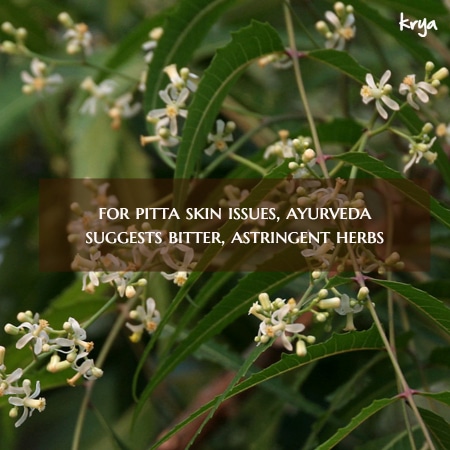
For vata related issues like perpetually dry skin, skin which is dull and lacks lustre and skin which is easily developing fine lines, wrinkles, etc we choose herbs which have Madhura Rasa, with ushna Veerya (hot potency) and have Snigdha guna (oiliy nature).
For Kapha related issues like eczema, psoriasis, or even basic clogging of skin like cystic acne, we choose cleansing herbs of Tikta (bitter) Rasa or Katu(pungent) Rasa and Ushna Veerya (hot potency) which easily penetrate skin, dissolve kapha blocks and improve skin quality .
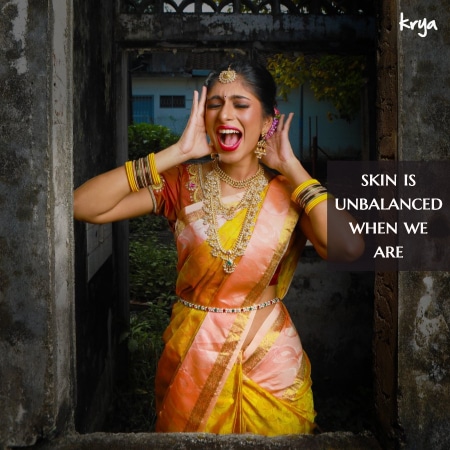
Alepana – Masking in Ayurveda and how it should be done
Alepana / Lipta / Lepana in Ayurveda is the process of applying a Mask / Lepa on skin / hair. This is used in 3 conditions: To balance the Doshas (Doshaghna), To remove poison from the body (Vishaghna) and to enhance skin qualities: Varnya.
The acharyas are very specific about the thickness of each kind of application. A doshghna Lepa must be applied the thinnest (specific thickness of Mask is also given), a Vishaghna Lepa must be applied with moderate thickness and a Varnya Lepa must be applied with maximum thickness. In all cases the width of your individual thumbnail (anguli) is taken as a benchmark.
Hence the Varnya Lepa must be applied to a thickness of ½ an anguli: or ½ the width of your thumbnail . For most people this is the thickness of 1 cm for the Mask.
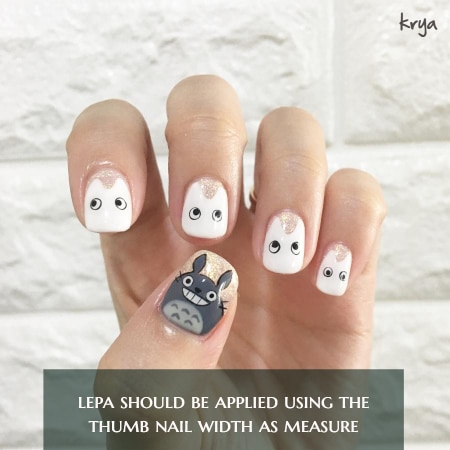
The acharyas also specify that the liquid / anupana used to mix the Mask is what delivers the nutrients from the mask into skin / hair. So they say that the Mask is ONLY effective when the Mask is moist / wet – when it dries the nutrient transfer does not happen on skin.
In fact, the acharyas further say that if we persist with leaving the Mask on after it gets dry, it does harm and not good to skin. When we leave Masks to dry out on skin, we unnecessarily stretch out the skin, leading to premature aging and skin wrinkling if done regularly.
This straight away are 2 fundamental Mask mistakes that most Youtubers and Beauty bloggers commit, inadvertently: 1: Apply the Mask as a thin and not thick layer, and 2. leave it on to dry out on skin.
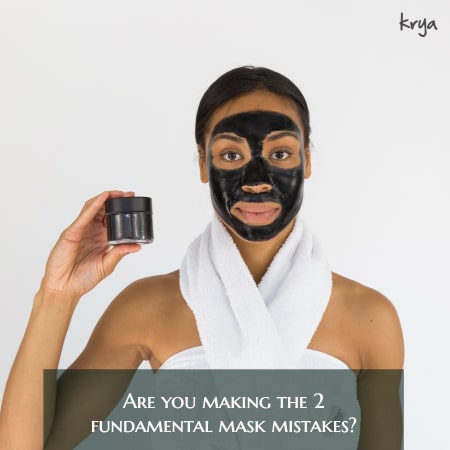
The only place in Ayurveda where Masks are allowed to dry out on skin is when we are trying to heal cases of Shotha / Oedema. Only here, do we allow the Lepa to slightly dry out on skin as the purpose here is to shrink the available space and bring down liquid accumulation in that part – this is done as a complement to internal medicine and not stand alone.. Even here it is not left in this state for too long.
How Krya Face Masks ( Lepas) are formulated:
Krya carries many 3 step skin care systems for different skin types and issues like acne, Normal – Oily Skin, Dry Skin, etc. we also carry products formulated for Teenagers with moderate to severe acne. All these systems have an important component in them: the Facial Mask / Lepa. We suggest using the Lepa once / twice a week as a part of a healthy skin care routine. Twice a week is suggested for chronic skin clogging like cystic acne.
Face Masks / Lepas are a critical skin improving aid in Ayurveda. We use Lepas to deliver a concentrated dose of nutrients to skin or hair. Because of the length of time a Lepa is left on skin, we can see very dramatic and recognizable improvements in facial skin after each Lepa application.
For vata prakriti skin, where skin is inherently tough, brittle and dry, Lepas help coax vata back into balance. With each use, we see skin becoming less uncomfortable, less taut and tight and sebum secretion is encouraged. We can also feel that the texture of skin is plumper and more supple and has an even, radiant appearance.
In most cases, you can choose the Face Mask / Lepa that goes with the face wash you are already using – for example Classic face mask if you are using Classic face wash. In a few tricky cases, where there are combination skin issues, I have recommended a Lepa from another range to go with your current face wash.
How to use a Krya Face Mask / Lepa?
The Krya Face Mask / Lepa are produced as concentrated Ayurvedic choornams. Each ingredient is separately and uniquely processed to suit a particular dosha and then harmoniously blended together.
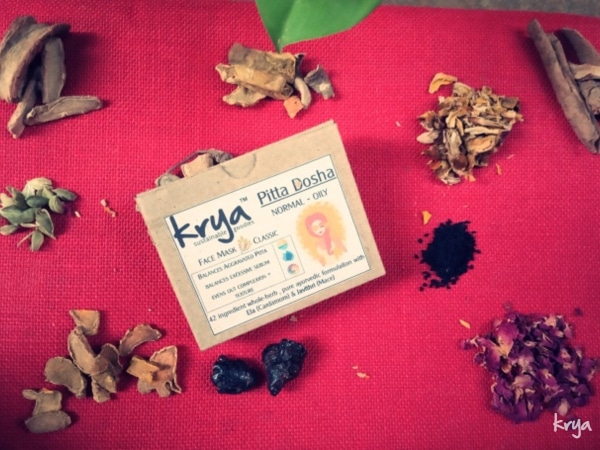
How to choose the correct Anupana / Mixing Medium for your Face Mask:
The Anupana (medium) of the Face Mask / Lepa is what allows the Herbs to interact with each other and also draws in the nutrients and enters the skin Srotas. So the choice of Anupana is critical to how well your Lepa works for you. Many blogs suggest all kinds of Anupana which have no mention in the Ayurvedic texts.
Some mixing mediums like Egg white, dry very quickly and pull and tighten the skin which is an absolute no in Ayurveda.
Curd is also not a suitable Anupana for either skin or scalp. By its nature it is “abhishyandi” / channel clogging , so it tends to block the Srotas (micro pores) in scalp and hair. When used on the scalp, it can also lead to the growth of fungal dandruff over time, as it is sweet and attracts such organisms.
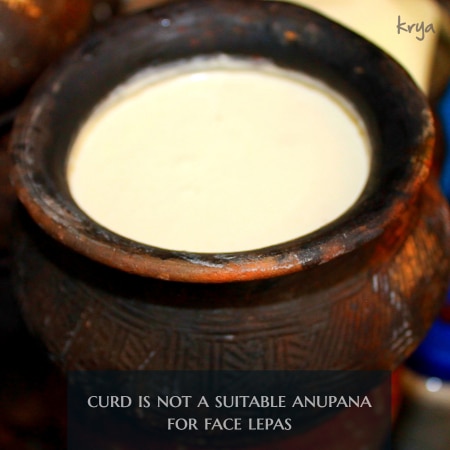
Many of you write to us asking about the use of different kinds of Honey as an anupana. Acharya Charaka and Acharya Sushruta have both recorded use of Honey in wound healing. Acharya Sushruta has advocated the use of Honey as a wound healing dravyas which keeps out micro organisms from wounds reducing the chance of infections.
Honey is a very powerful dravya in Ayurveda, but it is by nature Hot (ushna guna) and Drying (Rookshatva). This is why it is used so often in treating coughs and colds where its hotness and dryness helps balance coldness and wetness of Kapha dosha.
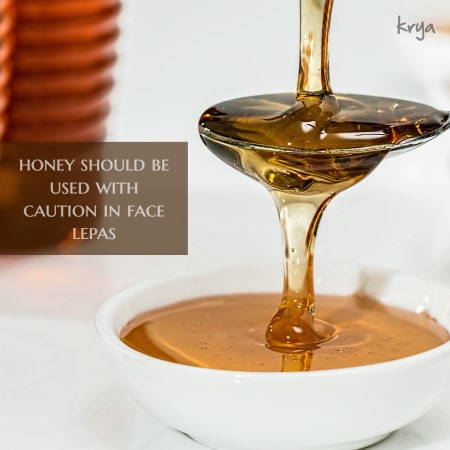
But this makes it unsuitable for many Lepa applications as these properties are not desired. It often triggers cystic acne especially if the skin is already dominant in pitta dosha because of its hot nature.
In Ayurveda the following Anupanas are universally permitted depending upon skin type and problems faced:
- Clean Water
- Cow’s Milk (preferably A2)
- Good quality, chemical free Rose Water
- Fresh Swarasa of certain plants (Fresh Aloe Gel which has been rinsed well to remove the irritant)
- Kashayas (decoctions) of ayurvedic herbs chosen for different skin types
If in doubt about how your skin will react to the Anupana, Water is the best choice or a carefully chosen Kashaya. Otherwise for drier skin types Milk or Milk with water is a good Anupana. If you have a tendency to break out and have Pitta leaning skin, Rose water or Aloe Gel or a combination of these with water can be used.
How to Mix your Face Mask / Lepa correctly
Mixing your Face Mask / Lepa to the correct consistency using the appropriate Anupana is a critical step. The Mixing of the Lepa ensures that the Anupana is well distributed among the herbs in the Choornam. The proper mixing also allows for the product to be easily applied on skin.
All Krya Face Masks / Lepas contain water soluble natural plant gums (whole and not extracted) like Babool Gond, Badam Gond, etc. The expand and have a gel like texture in the presence of water, adhering the herbs in a homogenous fashion. By themselves , the Plant Gums are also excellent nutrients for skin.
Please mix the required quantity of Face Mask / Lepa in the Anupana (medium) suggested for you. The product should be blended into a thick non drippy consistency, and left for 45 minutes before use. This allows the herbs to interact with the Anupana improving its potency.
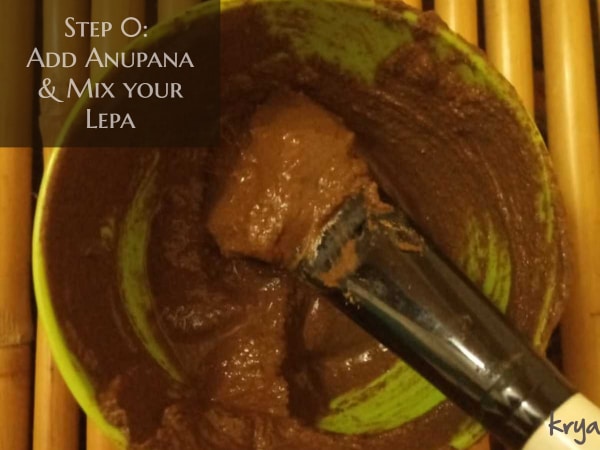
Cleansing your Skin – Pre-step to applying any Face Mask (Lepa)
All Ayurvedic Face Masks / Lepas MUST be applied on clean skin. This prepares the skin to receive the nutrients properly from the Lepa. This also ensures that nothing interferes with the action of the Lepa on skin like sebum, pollutants, grime, etc.
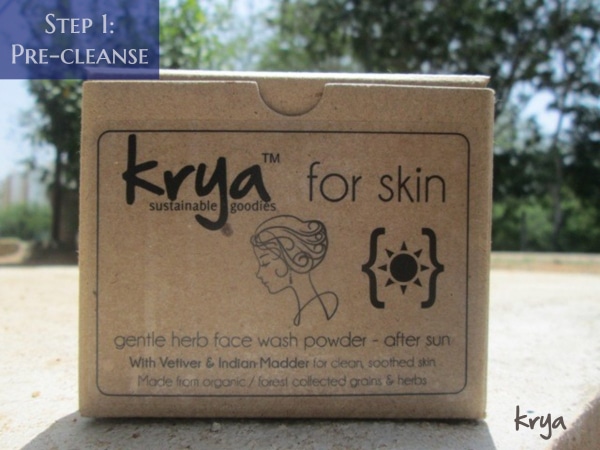
When cleansing the skin, care must be taken NOT to strip skin of its natural oils. When this is done, the Srotas become stiff and inflexible and are unable to receive the nutrients given by the mask properly. This is why we suggest pre-cleansing with any recommended Krya Face cleanser and not a synthetic soap or a face wash. If you have never used an Ayurvedic powder cleanser, do read this article to understand more about why this is better for skin.
Applying your Face Mask / Lepa
Using a Mask brush or clean fingers, apply the Mask on cleansed face and Neck leaving out the eye area.
Ayurveda advises applying the Mask, thick (to the width of ½ anguli – ½ the width of your thumbnail). This thickness allows the herbs to work slowly and deeply into skin. The thickness of the Ayurvedic Lepa also allows the Mask to be left on for longer on skin. A well applied Mask can sometimes take upto 40 minutes to dry in humid weather, giving the Skin that much more time to absorb the nutrients applied on.
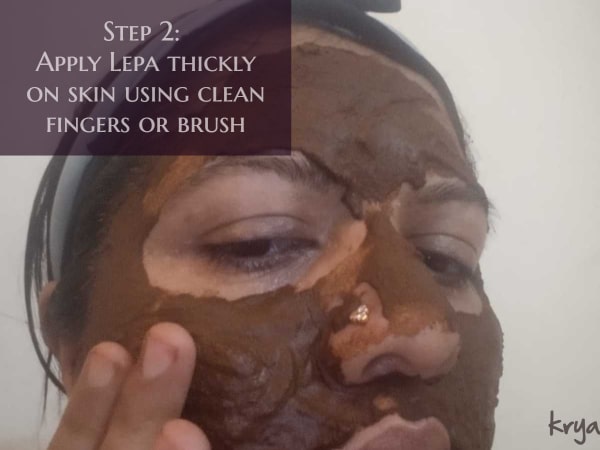
When the Mask begins to dry on skin, rinse it out with cool water. When mask is semi dry, if you touch it, you will see very small amounts of residue as it is beginning to dry.
Post Face Mask application: seal in Moisture using a Krya facial oil / serum
After Face Mask /Lepa, the Srotas of the skin are much more open due to the action of the Lepa. This unclogging action helps remove deeply embedded dead cells, oil plugs, etc. The Lepa also improves the action of the Srotas so they are flexible and help in proper conduct of heat, sweat and absorption of nutrients inwards.
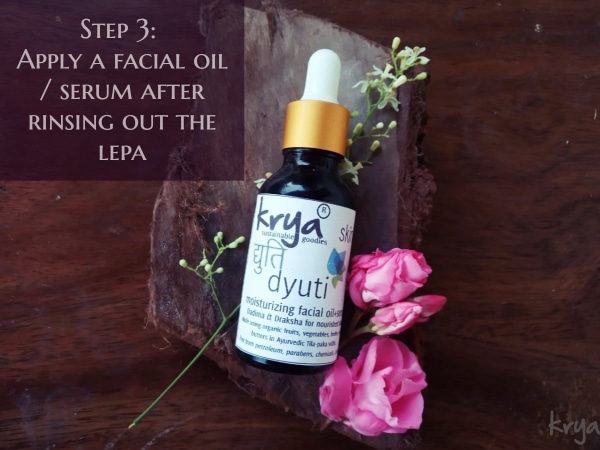
It is important to utilise this opportunity after Lepa, to deliver fresh nourishment to skin, as the Srotas are primed and ready to absorb it. So on clean damp skin (after rinsing out the Lepa properly), please pat in 1 – 2 drops of your recommended Krya Facial oil / serum and seal it in.
Sharing Preethi (Krya’s Co-Founder)’s Face Mask / Lepa Experience:
With the stress of the new website, hectic Deepavali preparations and extended travel, I really needed the pick me up of a good Facial Mask / Lepa last week. With the change in weather, Chennai has become slightly colder. So the corners of my mouth are appearing slightly drier than usual. So I wanted to change my Mask routine just slightly to adjust for this.
I used the Krya Classic Face Lepa (Mask) to suit my pitta-kapha skin. My skin is usually slightly oily, has a flushed appearance with prominent open pores. I also break out if I eat oily, sweet food , or if I go out in very dusty / polluted environments and do not cleanse skin properly. I started by using a combination of Krya Classic Face wash and Krya After Sun face wash to pre-cleanse the skin.
I mixed this Mask with ¾ rose water and a 1/4 boiled and cooled milk. I did not use the Cream / Malai as it can sometimes clog Pitta prakriti and Kapha prakriti skin. Only very dry skin types can tolerate it. I have added a very small amount of Milk to my mask to take care of the change in weather. This should not be used if you are currently experiencing break-outs / skin clogging – in this case, you can stick to Rose water or plain clean water for the Mask.
After mixing the Lepa to a thick non-drippy consistency I allowed it to stand for 20 minutes to allow the herbs to get activated in the presence of the Anupana / medium (rose water + milk). Then, using a Mask brush, I applied it thick onto skin using upward strokes. I waited for about 20 minutes until the Mask become semi dry and then rinsed it out.
Ayurvedic Face Masks must be applied thick and should NOT be allowed to dry out : if you allow the herbs to dry out on skin, it can cause premature aging and sagging of skin. If you apply the mask too thin, the herbs do not get enough time to slowly work on your srotas. So both these rules must be followed.
My results:
As you can see in the last photo in the collage – the skin looks extremely even, refined and matte in appearance. The skin also feels pleasantly refreshed, cool and clean.
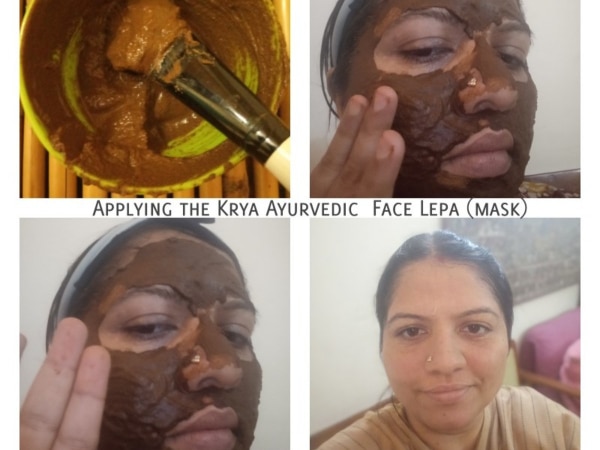
As the Lepa contains many pitta balancing agents, it is cooling in Nature. Hence we advise completing Masking before sun sets. If you are prone to colds / sinusitis, follow up with Rasanadi choornam inhalation and application on head.
The Face Lepa routine is also HIGHLY relaxing in nature so you might find yourself starting to doze off – DONT!!
I followed up the Mask with 2 drops of Krya classic skin facial oil serum + 1 drop of Vyoma skin serum to help seal in moisture. This amount of Moisturisation is usually sufficient for Pitta dominant skin. Such skin should not be over loaded with Moisturisers or with the wrong products as it will IMMEDIATELY react.
Products Used:
Krya Classic face wash + Krya After Sun Face wash + Krya Classic Face Lepa + Krya Classic Skin Oil serum + Vyoma Skin serum
To Sum up:
Ayurvedic Face Lepas are a powerful and potent aid to your skin care routine. When used regularly, a properly chosen and if correctly Face Lepa can boost the quality , texture and appearance of skin. Despite their potency, Face Lepas have to be chosen properly, mixed with the right Anupana (medium), and applied correctly to see the best results. Wrong application of Face masks can on the other hand tighten skin leading to dryness and over time, early aging.
This post was written to educate you on the way Ayurvedic face Lepas are formulated, how to choose the right Anupanas and how to mix and apply them properly on skin. Krya has a wide range of face lepas for different skin types and problems. Please explore them here. For any help on how to pick the right Krya face lepa or any other Krya product, please write to us or call us (0-75500-89090).

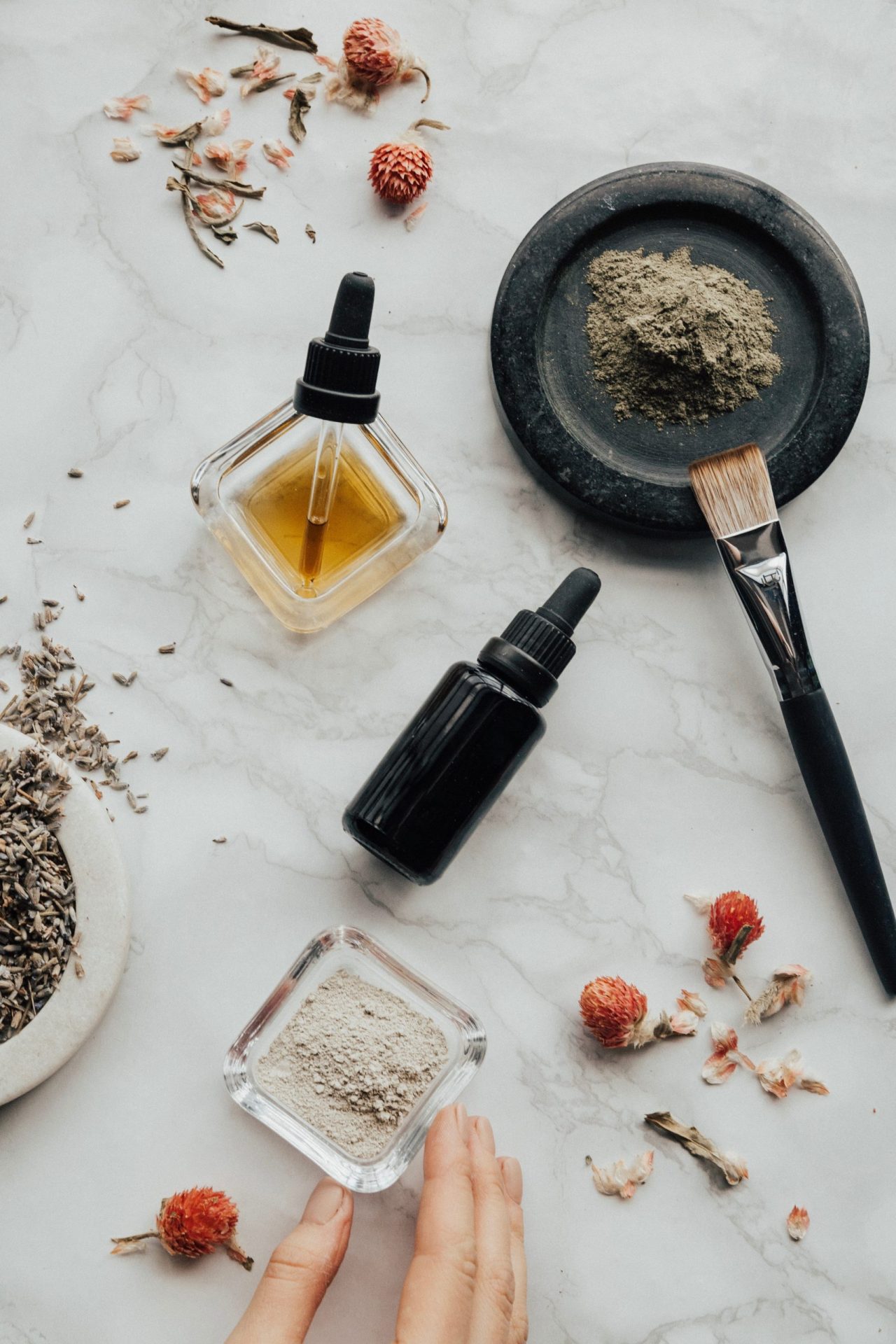
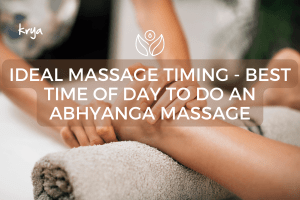

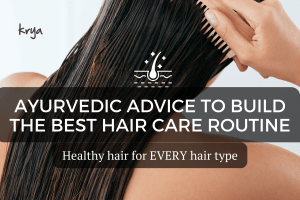

Really well done blog post! Thank you for the insights – especially about using curd and honey in masks.
Could you share which masks Sensitive skin types can use and how to use them correctly?
Thanks Supriya.
When you mention skin is Sensitive, do you mean it breaks out, goes red, develops rashes easily? In this case, Ayurveda would call this pitta dominant skin . For Pitta dominant skin either the Krya Classic face Mask or the Anti acne Face mask would suit.
hi, my facial skin has psoriasis lesions. can I use these masks to soften them ad also to even out the pigmentation because I have white patches all over
Hi Annupamaa,
Thank you for writing to us. Has the psoriasis completely healed? For this, we suggest using the Krya sensitive Skin Oil + Krya Sensitive Skin bodywash – the oil can be applied 2 – 3 times a day on the lesion and the wash can be applied as a Lepa / Mask and then rinsed out – these 2 products will work better at restoring the natural health and colour of the lesions than our other products.
It is also important to correct your diet so that you do not eat anything that further triggers psoriasis – It would be wise to consult a vaidya for this and follow the regimen suggested by them additionally.
Hi.
I have melasma with a thin skin type. Melasma on cheeks.
Dry skin which is dull and undernourished…Please suggest me the right products… Thankyou
Pratibha: can you please email us ([email protected] and [email protected]) . You may also send us a DM on whatsapp – +917550089090